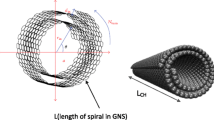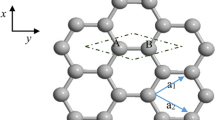Abstract
Graphene nanoscrolls (GNSs) as a new category of quasi one-dimensional (1D) belong to the carbon-based nanomaterials, which have recently captivated the attention of researchers. The latest discoveries of exceptional structural and electronic properties of GNSs like high mobility, controllable band gap, and tunable core size have become a great stimuli for graphene researchers. Due to the importance and critical role of nanoscale sensors and biosensors in medical facilities and human life, using a promising material like graphene has been widely studied to achieve better accuracy and sensitivity in these devices. Up until now, the majority of surveys conducted previously have focused on experimental studies for sensors family. Therefore, there is lake of analytical models in comparison to experimental surveys. In order to start and understand about the modelling of gas sensors structure, the field effect transistor(FET)-based structure is employed as a basic. In this study, graphene nanoscroll conductivity has been evaluated under the impacts which is induced by the adsorption of different values of NO2 gas concentration on GNS surface. So that, when GNS-gas sensor is exposed to NO2 gas molecules, the carrier concentration of GNS is changed which leads to the changes in the conductance, and consequently, in the current, this phenomenon is considered as sensing mechanism. The I–V characteristic of graphene nanoscroll-based gas sensor has been considered as a criterion to detect the effect of gas adsorption. In order to verify the accuracy of the proposed model, the results have been compared with the existing experimental works.









Similar content being viewed by others
References
Abadi H K F, Ahmadi MT, Yusof R, Saeidmanesh M, Rahmani M, Kiani MJ, Ghadiry M (2014) Development of carbon nanotube based biosensors model for detection of single-nucleotide polymorphism. Sci Adv Mater 6(3):513–519. doi:10.1166/sam.2014.1745. http://www.ingentaconnect.com/content/asp/sam/2014/00000006/00000003/art00013
Ahmadi MT, Webb JF, Amin NA, Mousavi SM, Sadeghi H, Neilchiyan MR, Ismail R (2011) Carbon nanotube capacitance model in degenerate and nondegenerate regimes. AIP Conf Proc 1337(1)
Akbari E, Yousof R, Ahmadi MT, Kiani MJ, Rahmani M, Feiz Abadi HK, Saeidmanesh M (2014) The effect of concentration on gas sensor model based on graphene nanoribbon. Neural Comput Applic 24(1):143–146. doi:10.1007/s00521-013-1463-2
Akbari E, Arora V, Enzevaee A, Ahmadi M, Khaledian M, Yusof R (2014) Gas concentration effects on the sensing properties of bilayer graphene. Plasmonics 9(4):987–992. doi:10.1007/s11468-014-9705-4
Bae Sukang KHLYXXPJ-SZYJOBAJ-HHBH (2010) Roll-to-roll production of 30-inch graphene films for transparent electrodes. Nat Nano 5(8). doi:10.1038/nnano.2010.132
Baskaran G (2012) Physics of quanta and quantum fields in graphene 91–129. doi:10.1002/9783527651122.ch3
Braga SF, Coluci VR, Legoas SB, Giro R, Galvo DS, Baughman RH (2004) Structure and dynamics of carbon nanoscrolls. Nano Lett 4(5):881–884
Cao A, Meng G, Ajayan PM (2004) Nanobelt-templated growth of carbon nanotube rows. Adv Mater 16(1):40–44. doi:10.1002/adma.200305667
Castro Neto AH, Guinea F, Peres NMR, Novoselov KS, Geim AK (2009) The electronic properties of graphene. Rev Mod Phys 81:109–162. doi:10.1103/RevModPhys.81.109
Chen CW, Hung SC, Yang MD, Yeh CW, Wu CH, Chi GC, Ren F, Pearton SJ (2011) Oxygen sensors made by monolayer graphene under room temperature. Appl Phys Lett 99(24). doi:10.1063/1.3668105. http://scitation.aip.org/content/aip/journal/apl/99/24/10.1063/1.3668105
Chen Y, Lu J, Gao Z. (2007) Structural and electronic study of nanoscrolls rolled up by a single graphene sheet. J Phys Chem C 111 (4):1625–1630. doi:10.1021/jp066030r
Choi KJ, Jang HW (2010) One-dimensional oxide nanostructures as gas-sensing materials: review and issues. Curr Appl Phys 10(4):1002–1004. doi:10.1016/j.cap.2009.12.024. http://www.sciencedirect.com/science/article/pii/S1567173909006117
Chu L, Xue Q, Zhang T, Ling C (2011) Fabrication of carbon nanoscrolls from monolayer graphene controlled by p-doped silicon nanowires: a md simulation study. J Phys Chem C 115(31):15217–15224. doi:10.1021/jp2030768
Datta S (2005) Quantum transport: atom to transistor
Akbari E, Arora VK, Enzevaee A, Ahmadi MT, Saeidmanesh M, Khaledian M, Karimi H, Yusof R (2014) An analytical approach to evaluate the performance of graphene and carbon nanotubes for NH3 gas sensor applications. Beilstein J Nanotechnol 5(1):726–734
Fang T, Konar A, Xing H, Jena D (2007) Carrier statistics and quantum capacitance of graphene sheets and ribbons. Appl Phys Lett 91(9). doi:10.1063/1.2776887
Grundmann M (2003) Nanoscroll formation from strained layer heterostructures. Appl Phys Lett 83(12)
Hamzah A, Ahmadi MT, Ismail R (2013) Quantum capacitance effect on zig-zag graphene nanoscrolls (zgns) (16, 0). Mod Phys Lett B 27(01):1350002. doi:10.1142/S0217984913500024
Hisamoto D, Lee W-C, Kedzierski J, Takeuchi H, Asano K, Kuo C, Anderson E, King T-J, Bokor J, Hu C (2000) Finfet-a self-aligned double-gate mosfet scalable to 20 nm. Electron Devices, IEEE Trans on 47(12):2320–2325. doi:10.1109/16.887014
Xia JLJ, Chen F, Tao N (2009) Measurement of the quantum capacitance of graphene. Nat Nanotechnol 4:505–509
Johari Z, Ahmadi MT, Chang D, Chek Y, Amin NA, Ismail R (2010) Modelling of graphene nanoribbon fermi energy 2010:2–7. doi:10.1155/2010/909347
Karimi Feiz Abadi H, Yusof R, Maryam Eshrati S, Naghib SD, Rahmani M, Ghadiri M, Akbari E, Ahmadi MT (2014) Currentvoltage modeling of graphene-based dna sensor. Neural Comput Applic 24(1):85–89. doi:10.1007/s00521-013-1464-1
Khaledian M, Ahmadi MT, Ismail R, Saeidmanesh M (2014) Structural and properties of graphene nanobelts rolled up into spiral by a single graphene sheet. J Comput Theor Nanosci 11(3):601–606. doi:10.1166/jctn.2014.3401
Kim KS, Zhao Y, Jang H, Lee SY, Kim JM, Kim KS, Ahn J-H, Kim P, Choi J-Y, Hong BH (2009) Large-scale pattern growth of graphene films for stretchable transparent electrodes. Nature 457(7230):706–710. doi:10.1038/nature07719
Kliros GS (2010) Quantum capacitance of bilayer graphene 01, 69–72
Ko H.-YAJPY-MLK-YKJ, Kim G (2010) Graphene-based nitrogen dioxide gas sensors. Sensors 10(4):4083–4099. doi:10.3390/s100404083. http://www.mdpi.com/1424-8220/10/4/4083
Li MFHYCLTC, Lin TS (2012) Quantum transport in carbon nanoscrolls. Phys Lett A 376(4). doi:10.1016/j.physleta.2011.10.049
Li X, Hao X, Zhao M, Wu Y, Yang J, Tian Y, Qian G (2013) Exfoliation of hexagonal boron nitride by molten hydroxides. Adv Mater 25(15):2200–2204. doi:10.1002/adma.201204031
Liang J, Akinwande D, Wong H-SP (2008) Carrier density and quantum capacitance for semiconducting carbon nanotubes. J Appl Phys 104(6). doi:10.1063/1.2986216
Lin Z-D, Hsiao C-H, Young S-J, Huang C-S, Chang S-J, Wang S-B (2013) Carbon nanotubes with adsorbed au for sensing gas. Sensors J IEEE 13(6):2423–2427. doi:10.1109/JSEN.2013.2256124
Lundstrom M, Guo J (2006) Basic concept,” in nanoscale transistors: device physics, modeling and simulation. ed 233 Spring Street, New York, NY 10013, USA: Springer 1–50
Lundstrom M, Guo J (2005). In: 1st edn. (ed) Nanoscale Transistors: Device Physics, Modeling and Simulation. Springer
Martins BVC, Galvão DS (2010) Curved graphene nanoribbons: structure and dynamics of carbon nanobelts. Nanotechnology 21(7):075710. doi:10.1088/0957-4484/21/7/075710
Meric Inanc.Han MYYAFOBKPSKL (2008) Current saturation in zero-bandgap, top-gated graphene field-effect transistors. Nat Publ Group, Nat Nano 3(11). doi:10.1038/nnano.2008.268
Mieszawska AJ, Jalilian R, Sumanasekera GU, Zamborini FP (2007) The synthesis and fabrication of one-dimensional nanoscale heterojunctions. Small 3(5):722–756. doi:10.1002/smll.200600727
Mintmire JW, White CT (1998) Universal density of states for carbon nanotubes. Phys Rev Lett 81:2506–2509. doi:10.1103/PhysRevLett.81.2506
Khaledian MSMTAEAM, Ismail Razal i (2014) Carrier statistics and quantum capacitance models of graphene nanoscroll. J Nanomater 2014:6. doi:10.1155/2014/762143
MohammadTaghi WRIMR, Jeffrey Frank .A (2012) Carbon-based materials concepts and basic physics, pp 65–98
Mpourmpakis G, Tylianakis E, Froudakis GE (2007) Carbon nanoscrolls: a promising material for hydrogen storage. Nano Lett 7(7):1893–1897. doi:10.1021/nl070530u. PMID: 17580924
Neto AC, Geim A (2012) Graphene: Graphene’s properties. New Sci 214 (2863). doi:10.1016/S0262-4079(12)61116-6
Nourbakhsh A, Cantoro M, Heyns MM, Sels BF, De Gendt S (2013) (invited) toward ambient-stable molecular gated graphene-fet: a donor/acceptor hybrid architecture to achieve bandgap in bilayer graphene. ECS Trans 53(1):121–129. doi:10.1149/05301.0121ecst. http://ecst.ecsdl.org/content/53/1/121.abstract
Novoselov KS, Geim AK, Morozov SV, Jiang D, Zhang Y, Dubonos SV, Grigorieva IV, Firsov AA (2004) Electric field effect in atomically thin carbon films. Science 306(5696):666–669. doi:10.1126/science.1102896. http://www.sciencemag.org/content/306/5696/666.abstract
Parkash V, Goel K (2008) Quantum capacitance extraction for carbon nanotube interconnects, pp 292–295
Peng X, Zhou J, Wang W, Cao D (2010) Computer simulation for storage of methane and capture of carbon dioxide in carbon nanoscrolls by expansion of interlayer spacing. Carbon 48(13):3760–3768. doi:10.1016/j.carbon.2010.06.038
Perim E, Galvao DS (2009) The structure and dynamics of boron nitride nanoscrolls. Nanotechnology 20(33):335702
Perim E, Paupitz R, Galvo DS (2013) Controlled route to the fabrication of carbon and boron nitride nanoscrolls: a molecular dynamics investigation. J Appl Phys 113(5). doi:10.1063/1.4790304
Pourasl A, Ahmadi M, Rahmani M, Chin H, Lim C, Ismail R, Tan M (2014) Analytical modeling of glucose biosensors based on carbon nanotubes. Nanoscale Res Lett 9(1). doi:10.1186/1556-276X-9-33
Seyed ANAHMA, Hassan Abedi, Alireza Ahmadzadeh (2014) The role of endoscopic ultrasound in primary pancreatic lymphoma presented with acute pancreatitis: a case report, Journal of the Pancreas 0(0). http://www.omicsonline.com/open-access/the-role-of-endoscopic-ultrasound-in-primary-pancreatic-lymphoma-presented-with-acute-pancreatitis-a-case-report-1590-8577-15-158.pdf
Qi Y-X, Li M-S, Bai Y-J (2007) Carbon nanobelts synthesized via chemical metathesis route. Mater Lett 61(45):1122–1124. doi:10.1016/j.matlet.2006.06.067. http://www.sciencedirect.com/science/article/pii/S0167577X06007737
Rurali VRC R, Galvao DS (2006) Prediction of giant electroactuation for papyruslike carbon nanoscroll structures: First-principles calculations. Phys Rev B 74(8). doi:10.1103/PhysRevB.74.085414
Dingle RB (1973) Asymptotic expansions: their derivation and interpretation. Academic Press Inc
Saeidmanesh M, Ismail R, Khaledian M, Karimi H, Akbari E (2013) Threshold voltage roll-off modelling of bilayer graphene field-effect transistors. Semicond Sci Technol 28(12):125020. http://stacks.iop.org/0268-1242/28/i=12/a=125020
Saeidmanesh M, Khaledian M, Ghadiry M, Ismail R (2014) Analytical study of subthreshold behaviour of double gate bilayer graphene field effect transistors. Semicond Sci Technol 29(11):115011. http://stacks.iop.org/0268-1242/29/i=11/a=115011
Schaper AK, Hou H, Wang M, Bando Y, Golberg D (2011) Observations of the electrical behaviour of catalytically grown scrolled graphene. Carbon 49(6):1821–1828. doi:10.1016/j.carbon.2010.12.066
Schwierz F (2010) Graphene transistors. Nat Nano, Nat Publ Group 5(7). doi:10.1038/nnano.2010.89
Shi P N M G H , Xinghua (2010) Mechanics of carbon nanoscrolls: a review. Acta Mech Solida Sin 23(6). doi:10.1016/S0894-9166(11)60002-5
Shi X, Pugno. NM, Gao H (2010) Mechanics of carbon nanoscrolls: a review. Acta Mech Solida Sin 23(6):484–497. doi:10.1016/S0894-9166(11)60002-5
Sinha N, Ma J, Yeow JTW (2006) Carbon nanotube-based sensors. J Nanosci Nanotechnol 6(3):573–590. doi:10.1166/jnn.2006.121
Skotnicki T, Hutchby JA, King T-J, Wong H.-S.P., Boeuf F (2005) The end of cmos scaling: toward the introduction of new materials and structural changes to improve mosfet performance. Circ Devices Mag IEEE 21 (1):16–26. doi:10.1109/MCD.2005.1388765
Soldano C, Mahmood A, Dujardin E (2010) Production, properties and potential of graphene. Carbon 48(8):2127–2150. doi:10.1016/j.carbon.2010.01.058. http://www.sciencedirect.com/science/article/pii/S0008622310000928
Viculis LM, Mack J J, Kaner RB (2003) A chemical route to carbon nanoscrolls. Science 299 (5611):1361. doi:10.1126/science.1078842
Wallace PR (1947) The band theory of graphite. Phys Rev 71:622–634. doi:10.1103/PhysRev.71.622
Wang X, Ouyang Y, Li X, Wang H, Guo J, Dai H (2008) Room-temperature all-semiconducting sub-10-nm graphene nanoribbon field-effect transistors. Phys Rev Lett 100:206803. doi:10.1103/PhysRevLett.100.206803
Wei L, Frank DJ, Chang L, Wong H-SP (2011) Noniterative compact modeling for intrinsic carbon-nanotube fets: quantum capacitance and ballistic transport. Electron Devices, IEEE Trans on 58(8):2456–2465. doi:10.1109/TED.2011.2153858
Wisitsoraat A, Tuantranont A (2013) In Applications of nanomaterials in sensors and diagnostics, pp 103–141
Xi G, Zhang M, Ma D, Zhu Y, Zhang H, Qian Y (2006) Controlled synthesis of carbon nanocables and branched-nanobelts. Carbon 44 (4):734–741. doi:10.1016/j.carbon.2005.09.017. http://www.sciencedirect.com/science/article/pii/S0008622305005592
Xia D, Xue Q, Xie J, Chen H, Lv C, Besenbacher F, Dong M (2010) Fabrication of carbon nanoscrolls from monolayer graphene. Small 6(18):2010–2019. doi:10.1002/smll.201000646
Xia F, Farmer DB, Lin Y-m, Avouris P (2010) Graphene field-effect transistors with high on/off current ratio and large transport band gap at room temperature. Nano Lett 10(2):715–718. doi:10.1021/nl9039636. PMID: 20092332
Xie X, Ju L, Feng X, Sun Y, Zhou R, Liu K, Fan S, Li Q, Jiang K (2009) Controlled fabrication of high-quality carbon nanoscrolls from monolayer graphene. Nano Lett 9(7):2565–2570. doi:10.1021/nl900677y. PMID: 19499895
Yan F, Zhang M, Li J (2014) Solution-gated graphene transistors for chemical and biological sensors. Adv Healthc Mater 3(3):313–331. doi:10.1002/adhm.201300221
Zhang FY-JZ-YSX-CWL-NCL, Yan-Qin (2013) A novel glucose biosensor based on the immobilization of glucose oxidase on layer-by-layer assembly film of copper phthalocyanine functionalized graphene. Electrochim Acta 104. doi:10.1016/j.electacta.2013.04.099. http://www.sciencedirect.com/science/article/pii/S001346861300769X
Acknowledgments
The authors would like to acknowledge the financial support from the Research University grant of the Ministry of Higher Education (MOHE), Malaysia, under project Q.J130000.2523.04H99. Also, we would like to thank the Research Management Center (RMC) of the Universiti Teknologi Malaysia (UTM) for providing an excellent research environment where we completed this work.
Author information
Authors and Affiliations
Corresponding author
Rights and permissions
About this article
Cite this article
Khaledian, M., Ismail, R., Saeidmanesh, M. et al. Sensitivity Modelling of Graphene Nanoscroll-Based NO2 Gas Sensors. Plasmonics 10, 1133–1140 (2015). https://doi.org/10.1007/s11468-015-9905-6
Received:
Accepted:
Published:
Issue Date:
DOI: https://doi.org/10.1007/s11468-015-9905-6




